An Economy Tour of the Northern Rhône: Ambitious Appellations Capture Syrah’s Flavors and Emotions in Open and Easy-Going Manners (7-Bottle Sampler $249) + Saturday Sips
Join Us for Saturday Sips
Come as you are; come any time that’s convenient for you during our business hours to sample selection from this week’s selections. Our staff will be on hand to discuss nuances of the wines, the terroirs reflected, and the producers.
The price of a barrel of crude oil rises and falls on political whims, but the price of fine wine seems locked into an upward trajectory. Take that truism to the bank and take the bottle to the vault. It’s one of the reasons people invest in wine, especially in excellent vintages from top houses. But this is not to suggest that reliable bargains cannot be found in large, ambitious appellations set in ideal climates where certain noble varieties flourish … like Syrah.
As a varietal, Syrah wears many faces and goes by several names; Shiraz is the most common, of course, and is the one preferred by the New World. But Syrah may also be disguised as Balsamina, Candive, Entournerein or Hignin Noir. As varied as the names is the grape’s profile—floral in youth and then developing white and black pepper aromas and herbaceous notes as it ages. The fruit tends towards the dark flavors of blackcurrant and the spice toward licorice and cola.
Northern Rhône is the fountain from which the most spectacular Syrahs spring, especially in the Côte-Rôtie, Hermitage, Cornas, Crozes-Hermitage and Saint-Joseph appellations, where the earthy, savory style can improve for many years inside the bottle. The granite slopes on which the vineyards of Northern Rhône are planted can be brutal in growers—some are so steep that pulley systems are used for grapes and equipment. Techniques like these add substantial costs to wine production, so when you see a reasonable price affixed to a bottle from Northern Rhône, be assured that the profit margin for the winemaker is probably less than a gluggable Shiraz grown on a flat plateau in Adelaide’s Riverland.
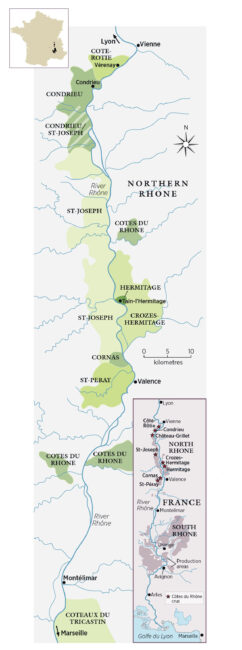
This week’s package contains examples of Northern Rhône wines that strike the ideal balance sought by people who consume rather than collect—smoky complexity, Syrah typicity, and lovely drinkability and at a price that will not require a second mortgage.
Northern Rhône Royalty: Côte-Rotie, Cornas and Hermitage
The triumvirate of Côte-Rôtie, Cornas and Hermitage rule the narrow terraces of Northern Rhône indomitably and are responsible for the world’s most superlative Syrahs. They’ve been called ‘unicorn wines’ in that the best of them are rare, and if available, very expensive.
Rolling above the town of Ampuis, the roasted slopes of Côte-Rôtie have several distinct personalities, one most suitable for wine, the others, less so. Only the south and south-east facing hillsides on right bank of the river are worth the discomfort of cultivating and picking, while those to the south—collectively known as the Côte Blonde—produce similar but earlier drinking wines than those produced on the Côte Brune to the north (although traditionally, the wines from these areas have been blended).
One of the smallest appellations in Rhône, Cornas is under three hundred acres—smaller than some single estates in Bordeaux. It produces only red wines made exclusively from Syrah—a variety that ripens with greater ease here than virtually anywhere else in Northern Rhône. Celtic for ‘burnt earth’, Cornas wines—in homage to the name or vice versa—frequently reflects smoky notes with deep, burly earth tones. Once considered ‘country wines’ of value only to those who love rusticity, the reputation of Cornas has skyrocketed in recent vintages to become one of the most sought after wines in France.
From a handful of vineyards, Hermitage is responsible for some of France’s most enduringly prestigious wines, in part by allowing the addition of 20% Viognier to its Syrah. Whether white or red, these gems are long-lived and full-bodied. Terroir, of course, is lifeblood: The granite hillside where the Hermitage vineyards are planted face south, overlooking a short section where the river Rhône flows west to east rather than north to south. This orientation means that the grapes benefit from the maximum amount of sunlight throughout the day.
The Sleeping Beauties of the Northern Rhône
A number of smaller, previously dormant areas that nestle in pockets near the big-name appellations in the Rhône have begun a remarkable comeback; this is the result of hard work by few steadfast vignerons who have saved noteworthy properties from being reclaimed by forest. It is among these parcels of land, which peek through mostly unfriendly hinterland that we make our modern-day discoveries— worthy and exciting Syrahs; the best made since the phylloxera blight wiped out the original vineyards in the 1800s.
Domaine Les 4 Vents
Formerly Le Domaine de Lucie, the 25-acre domain was renamed when Nancy Cellier joined her sister Lucie Fourel at the helm of the family estate in Crozes-Hermitage. The new name was borrowed from the nearby auberge (country inn) once owned by Lucie and Nancy’s great grandparents.
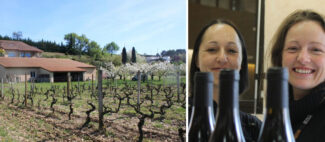
Sisters Nancy and Lucie Fourel, Domaine les 4 Vents
Before returning to the estate, Lucie spent a few years as an apprentice with different wineries in the Rhône Valley—time she spent developing both the philosophy and practices for bio-dynamic farming and natural vinification for which the domain has obtained certification. Lucie does not use sulfur during the winemaking process and only just before bottling does she add a minimal dose and the wines are fermented using only indigenous yeasts.
“We are in perpetual search of respecting the environment,” says Lucie. “Our interventions in the vineyard or in the cellar aim to accompany the grapes, then the wine, towards its most authentic expression”.
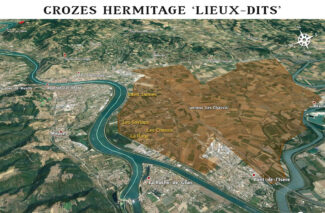
Crozes-Hermitage
Crozes-Hermitage is the largest of the Northern Rhône appellations, but it labors in the shadow of its storied namesake Hermitage without pretentions of equality. Price reflects that, of course, and the wine itself does hold at least some measure of the magnificence found in its massive, long-lived neighbor. The wine-growing region has a continental climate distinct from the Southern Rhône, and its sheer size adds to the diversity of its terroir. Soils south and southwest toward Gervans largely consisting of granite and clay, while Tain-l’Hermitage is primarily made up of rocks, sand, and clay. The flatter topography in the southern Crozes-Hermitage area is primarily alluvial soil due to Rhône river deposits.
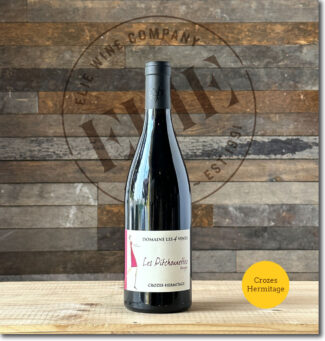 Domaine Les 4 Vents ‘Les Pitchounettes’, 2020 Crozes-Hermitage Rouge ($28)
Domaine Les 4 Vents ‘Les Pitchounettes’, 2020 Crozes-Hermitage Rouge ($28)
‘Les Pitchounettes” is a cuvée that originates from relatively young vines in the lieu-dit Les Chassis near the village of Mercurol where the soil is a sandy-silty alluvial clay with a lot of surface river stones. Yields are very low, typically around 30 hectoliters per hectare and harvesting is done by hand. The grapes are de-stemmed and the juice is left to macerate with the skins for three weeks with very little rémontage or pigéage (pumping over or punching down the cap). The wine shows classic Syrah flavors of black fruit and smoky pepper accented by cedar, vanilla and tobacco.
Domaine Eric et Joël Durand
Like Domaine Les 4 Vents, this is a sibling operation: Brothers Éric and Joël Durand produce wine from fifty acres of vines about six miles south of Tain l’Hermitage.
First joining forces in 1996, the brothers are devoted to ‘the polycultural family business of cultivating grapes’. The domain itself is based in Châteaubourg in the Ardèche; their Syrah, Marsanne and Roussanne grapes farmed over the appellations of Cornas, Saint-Péray and Saint-Joseph in addition to the IGP of Collines Rhodaniennes.
The brothers are firm believers that in order to make great wine, you must begin with great grapes, and to achieve this, “you must have impeccable vineyards.”
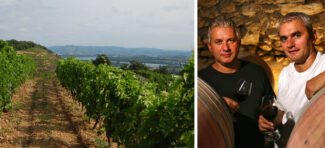
Éric and Joël Durand, Domaine Durand
Says Éric, “We work hard in each of parcels, not only managing the plants, but also maintaining and rebuilding the terraces on which they are planted. On these predominantly granitic slopes, we find that the noble Syrah grape finds fantastic expression.”
Saint-Joseph
St-Joseph covers a lot of territory and multiple terroirs; it encompasses 26 communes and stretches from Chavanay in the north to Châteaubourg in the south, roughly 30 miles in length. The reds from the region tend to be light for Rhônes, a result of soils containing less granite and vines that face east rather than south. But in strong vintages, they are spectacular.
Saint-Joseph reds must be 90% Syrah, but are allowed have up to 10% Marsanne or Roussanne as a blend, although in practice, most are pure Syrah showing classic notes of roasted meat and sweet spices. Most are ready to rock upon release, but may benefit from a bit of short-term cellaring, generally less than a year, although a select few may rival a great Côte-Rôtie or Hermitage.
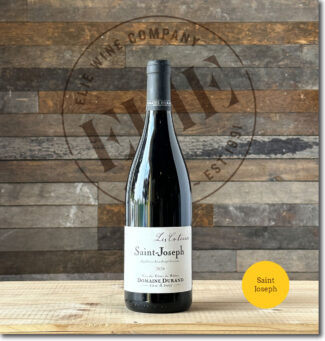 Domaine Eric et Joël Durand, 2020 Saint-Joseph ‘Les Coteaux’ Rouge ($35)
Domaine Eric et Joël Durand, 2020 Saint-Joseph ‘Les Coteaux’ Rouge ($35)
‘Les Coteaux’ means ‘the hills’, and true its name, the lieu-dit is found on a granitic slope where the vines are between 20 and 30 years old. The wine shows iron, iodine and smoky gravel behind rich blackberry extract with a rich cocoa and crushed stone finish.
Saint-Péray
Saint-Péray may be Northern Rhône’s biggest curiosity, an appellation known for whites and sparkling wine. These anomalies are predominantly produced from Marsanne, while Roussanne makes up the remainder of the vine space. Found near the southernmost limit of Northern Rhône region, it encompasses a mere 185 acres of vines.
Made via ‘méthode traditionelle’, the sparkling wines of Saint-Péray are relatively light-bodied, as are the still whites. This is due in part to limestone-rich soils and also to the immediate local topography, where the climate is not as hot as most locations in the valley.
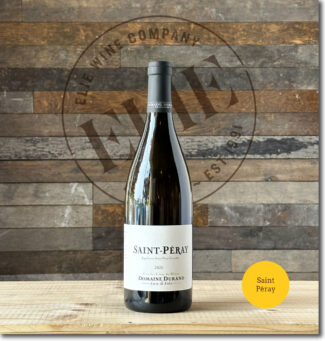 Domaine Eric et Joël Durand, 2020 Saint-Péray Blanc ($30)
Domaine Eric et Joël Durand, 2020 Saint-Péray Blanc ($30)
A blend of 50% Marsanne and 50% Roussanne grown in clay and limestone soils, the wine appears mid-gold in color and exhibits summery freshness on both nose and palate. Flavors of apricot and ripe stone fruits balance orange citrus to create a dynamic interplay of richness and zing with beautiful intensity beneath and a long, elegant finish.
Martin Texier
Domaine de l’Amandier
Martin Texier is the son of the well-known natural wine producer, Éric Texier, but for a while, he resisted the lure of the vine by studying economics, then becoming an accomplished DJ. But the family fate/curse began to show up in New York, where he learned about the trade via internships at Uva Wines in Brooklyn and Flatiron Wines in Manhattan.
He began making wine in 2014, and now owns twelve acres near Saint-Julien-en-Saint-Alban, where he raises classic Rhône varieties, red and white. Soils are varied; clay, limestone, gneiss, schist and granite allowing a wide range of styles of wine.
Says Martin, “My passion is to revive the local traditions of working the natural way, both in the vines and in the cellar, which includes native yeast fermentations and no sulfur.”
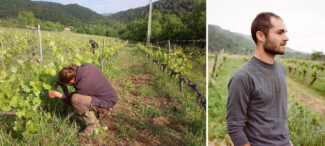
Martin Texier, Domaine de l’Amandier
Martin considers himself an artisanal, organic winemaker pushing for a new wave of natural, non-manipulated wines, and his winery is part of a community of thriving craft producers of (among other things) cheese and honey. The results he has been getting this early in his career are clear testament not only to his skills, but to his commitment to the planet: “A good winemaker isn’t an artist but a poet. As a grower, you can have an impact on your product by knowing your land, your trees, your vines and the weather. I don’t think you can create a good wine, but only create an environment from which a good wine can spring.”
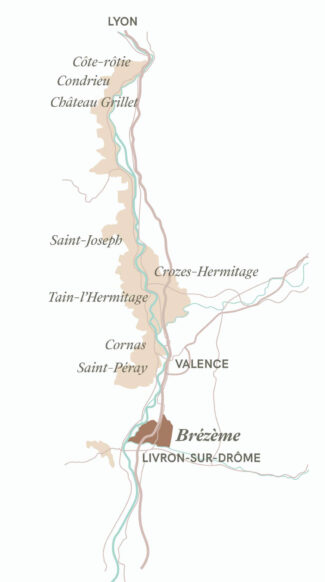
Côtes-du-Rhône Brézème
Brézème sit on the northern tip of Côtes du Rhône, alone in that it has no official status. It owes its official acceptance to history, as the Brézème name on wine labels predates the establishment of the appellations system in the 1930s.
The growing zone is located around the town of Livron-sur-Drôme on the northern bank of the Drôme river just before it flows into the Rhône. Although the potential vineyard area reportedly spans 200 acres, only around fifty acres are currently directed to the production of Brézème wine.
Predominantly Syrah, the vineyards are found on south-facing hillsides immediately overlooking the Drôme river just east of Livron, although vineyard land extends to the terraces of Fontgrand, three miles to the north.
Soils are generally limestone-marl, and depending on the location, they may also be rich in ferrous minerals, sand and pebbles.
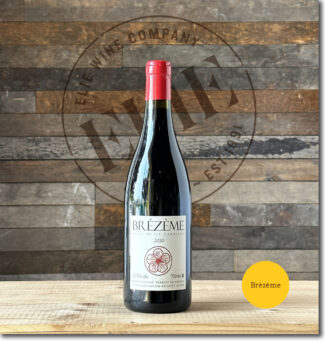 Martin Texier ‘Vigne de la Carrière’, 2020 Côtes-du-Rhône Brézème Rouge ($37)
Martin Texier ‘Vigne de la Carrière’, 2020 Côtes-du-Rhône Brézème Rouge ($37)
An organic and low sulfur Syrah that showcases the character of Brézème’s limestone slopes with impressive fruit density: Plum jam and ripe blackberries mixed with violet appears on the nose, and the palate is evidence of the ripeness of the vintage without become cloying or overly dense.
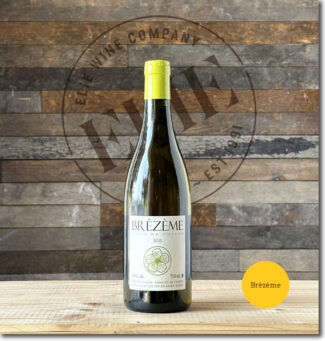 Martin Texier ‘Vigne du Coteaux’, 2021 Côtes-du-Rhône Brézème Blanc ($49)
Martin Texier ‘Vigne du Coteaux’, 2021 Côtes-du-Rhône Brézème Blanc ($49)
This Roussanne comes from Texier’s young vines in the cooler, more limestone-driven vineyards of Brézème. The vines are farmed organically; the grapes are fermented whole-cluster, then pressed and fermented on native yeasts, followed by lees-aging in concrete without stirring and only minimal sulfur added at bottling. It is a remarkably complex and textured wine from vines so young, revealing exotic spices, melon and a salty edge to the finish.
Collines Rhodanienne IGP
‘IGP’ is the Europe-wide equivalent of ‘Vin de Pays’, a classification that focuses on geographical origin rather than style and tradition, giving winemakers greater stylistic freedom than ‘AOP’. Collines Rhodaniennes is in the northern Rhône Valley, and covers an area from Lyon to Montélimar and includes some of southern France’s most famous AOP appellations, including Côte Rôtie, Condrieu and Hermitage.
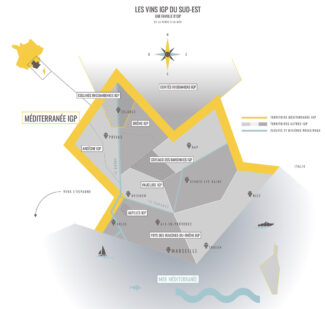
Domaine Georges Vernay
Few winemakers can claim to have brought home wine scores of 100 points, and even fewer can be credited with saving an appellation and a grape variety. Enter the Vernay family: Founded by Françis Vernay in 1937 in the heart of Condrieu, the efforts of Françis were instrumental in the creation of the official Condrieu appellation in 1940. Francis was succeeded by his son Georges, who played a key role in restricting the geographical boundaries of Condrieu and has been honored as having saved the appellation, which grows Viognier exclusively, from extinction.
In 1996, when her brothers showed little desire to take over the family estate Georges’ daughter Christine came on board as winemaker and General Manager of the estate and is now considered one of the great winemakers in France; several of her wines have recently been awarded the coveted 100/100 in top wine publications. Sadly, Georges Vernay passed away at the age of 92 in 2017.
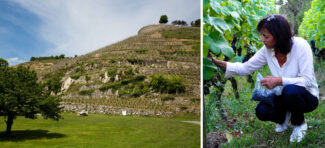
Christine Vernay, Domaine Georges Vernay
Under Christine’s direction, the fifteen-acre estate expanded their lineup by introducing a new from the Saint-Joseph appellation, La Dame Brune. Their best vines are planted on steep, hillside terroirs with granite and sandy soils. All work in the vineyards is organic and the winery was certified organic in 2019.
Christine says (with pride rather than bitterness), “Twenty years ago, it was rare for women to take over a wine estate, so I wasn’t even considered as a future manager. As the daughter of the so-called Pope of Condrieu who believed in the potential of the Viognier white grape variety from the 1970s, I only started working on this project at the age of 39. My father had saved the Condrieu appellation, pinning his hopes on the vineyard rather than cherry plantations or the cultivation of Ratte potatoes and peas, which were favored by many farmers at the time.”
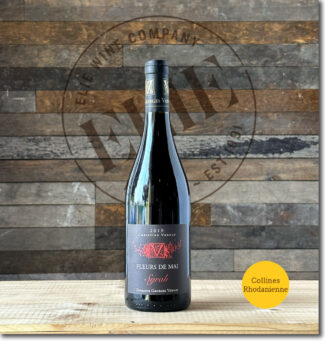 Domaine Georges Vernay ‘Fleurs de Mai – Syrah’ Christine Vernay, 2019 Collines Rhodanienne IGP Rouge ($34)
Domaine Georges Vernay ‘Fleurs de Mai – Syrah’ Christine Vernay, 2019 Collines Rhodanienne IGP Rouge ($34)
From 50-year-old Syrah vines planted adjacent to Condrieu, the grapes ferment in stainless steel and barrel and then age about 8 months in wooden vats. The profile is nearly identical to a top Côte-Rôtie, with an opening whiff of violet and cherry puree giving way to savory game and cassis notes.
Domaine Stéphane Ogier
Rooted in Ampuis for seven generations, the Ogier family is blessed with some truly remarkable soil. Under the direction of Stéphane Ogier, the estate manages 27 acres in some of the top Côte-Rôtie terroirs—Lancement, Côte-Rozier and La Viallière. Among the ironies inherent in having seen so much change in the region is that back in the 1950s, the family’s apricots sold for more than their grapes.
In the past twenty years, the winery has grown from producing 15,000 bottles annually to more than a quarter million in 2022, and is widely regarded as a reference point for the appellation.
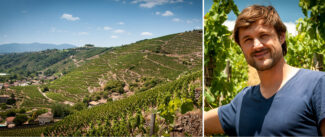
Stéphane Ogier, Domaine Michel et Stéphane Ogier
Having decided at the age of six to pursue winemaking, Stéphane Ogier first studied viticulture and oenology in Beaune and then did practical trainings with some of the best winemakers in Burgundy and abroad. During this time, he grew his philosophy of winemaking and his laser-like focus on terroir and now farms 12 individual parcels in Côte-Rôtie as well as others in Condrieu, Côtes du Rhône and Vienne.
Of particular interest is his holding in Collines Rhodanienne, of which Stéphane says: “It’s the same land as Côte Rôtie but not in the appellation. My first vintage was 1991, and the wine is made the same way as the Côte Rôties.”
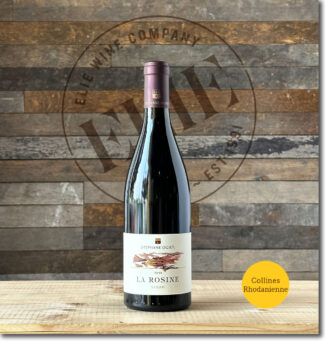 Stéphane Ogier ‘La Rosine – Syrah’, 2018 Collines Rhodanienne IGP Rouge ($38)
Stéphane Ogier ‘La Rosine – Syrah’, 2018 Collines Rhodanienne IGP Rouge ($38)
An exquisitely detailed, vineyard-designated wine from a steep-pitched, granite-rich parcel two miles from the famed Côte Blonde. La Rosine is said to be Stéphane Ogier’s ‘secret weapon’ in his vineyard-specific arsenal. All the pedigree of a Northern Rhône powerhouse without the price tag; it blends scents of anise, black olives, cola and plums, revealing substantial complexity in the full, fruit-centered body.
NEW ARRIVAL
Domaine François & Fils
Getting It Right in Côte Rôtie: ‘A Great Deal of Freshness and Elegance’
The François family paints an interesting portrait—their main occupation is farmhouse cheese making made using milk from their herd of cows. Wine appears to have begun as an afterthought, and even today, they sell all but their finest grapes to négociants.
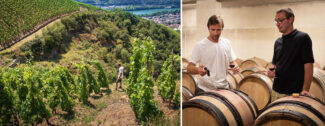
Brothers Erwan and Yoann François, Domaine François & Fils
Yoann François was the main catalyst in expanding the family’s wine label; of the ten acres they own, he champions their Côte-Rôtie which is made using grapes from three south-facing parcels, ‘Les Rochains’, ‘Rozier’ and ‘Le Bourrier’, accounting in total for account for about 3.7 acres. All three lieux-dits are located in the ‘Côte Brune’ region where vineyards are very steep and soils are composed of mineral-rich mica-schist—a good base for the 30-year-old vines of Syrah and Viognier. The vines are planted at a density of 8,000 to 9,000 per hectare and yields are 35 to 40 hectoliters per hectare.
Côte Rôtie: Single Site (Lieu-dit) Revival
Lieux-dits are a wine lover’s Google Earth; a satellite view of an appellation focused on a tiny, representative parcel. Not all vineyards have lieux-dits, and among those that do, not all are created equal. In general, it’s a term that refers to a geologically homogenous portion of a vineyard with a self-contained story to tell about its quality or, occasionally, its significance to history. Although lieux-dits are generally not required to be formally registered, they are always named, and that name may occasionally be confused with a producer’s cuvée name, which is often similar. Different appellations have different laws regarding lieux-dits; in Alsace, for example, they are mandatory for Grand Cru AOP labels, whereas in Burgundy, Grand Crus are forbidden from using them.
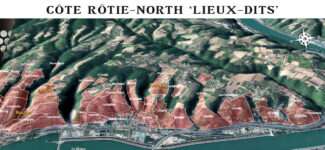
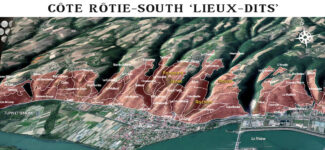
In the Rhône, lieux-dits are often associated with the region’s top estates, and those that do not have an officially registered place in the French Cadastre are considered ‘les marques’ of their producers. In either case, they are ‘terroir distilled’—an extremely fine-tuned expression of an individual location. To recognize one is to recognize that within the sprawling Rhône there exists an almost microscopic essence that only a lieu-dit can reveal.
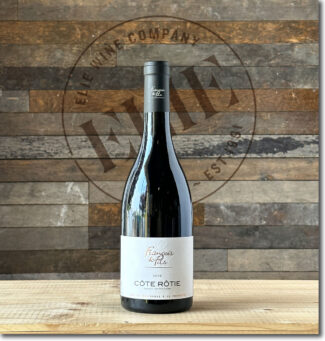 François & Fils, 2019 Côte-Rôtie ($67)
François & Fils, 2019 Côte-Rôtie ($67)
This traditional co-ferment contains 4% Viognier to add perfume to the Syrah; it shows finessed aromatics, powerful spice and balanced structure, violet, white pepper, black fruit and nutmeg, drawing a bit from each of the four Côte Brune lieux-dits that make it up: Le Bourrier, Fongeant, Janet and Rozier.
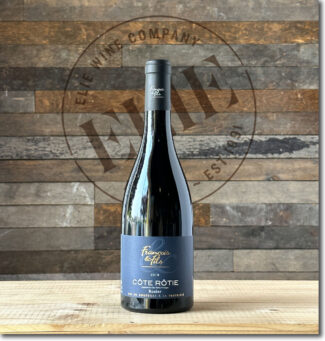 François & Fils, 2019 Côte-Rôtie ‘Rozier’ ($81)
François & Fils, 2019 Côte-Rôtie ‘Rozier’ ($81)
Rozier, in the Côte Brune, offers a perfect south-west exposition and vines around fifteen years old. The wine shows sunbaked earth and iron behind plush, plump notes of cassis balanced by a zesty spine of acidity and finishing long with hints of licorice and chocolate.
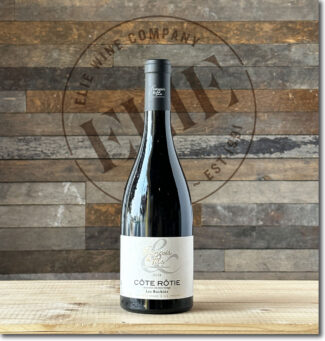 François & Fils, 2019 Côte-Rôtie ‘Les Rochins’ ($108)
François & Fils, 2019 Côte-Rôtie ‘Les Rochins’ ($108)
Les Rochins is a very steep parcel next to La Landonne and Rozier and folded into schist soils with iron and clay, producing dark, full-bodied wines that an benefit with some bottle age. This one shows ripe black cherries, incense, brambly blueberries and roasted meat along with loads of ultra-ripe tannins.
Vintage Journal
2021
Like most of France in 2021, the Rhône Valley suffered from a difficult growing season. The winter and early spring was relatively dry, although temperatures were so mild that there was premature vine growth. This was followed by a series of hard frosts that dramatically cut yields, and the bunches that remained intact were subject to disease during an unusually humid summer. Cloudy skies prevented even ripening and brought devastating storms in July and August. The grapes were slow to reach phenolic ripeness and, as a result, the harvest was later, longer and slower than normal. The wines have good structure and acidity and although alcohol was lower than in other years, there was still enough to assure body. For the big red appellations like Saint-Joseph and Hermitage, black and white pepper notes come through strongly, but the wines themselves tended to be more restrained, favoring elegance over bombast. The whites are fresh, elegant and aromatic rather overblown.
2020
The most notable features of 2020 are beginning to sound like a ‘new normal’: Drought, heat and an early harvest. Gratefully, heavy rains in the previous October, November and December that created reserves the vines could draw from. Rain fell in May and June, although the rest of the growing season was exceptionally dry. Guillaume Sorrel (Domaine Marc Sorrel) went as far as to say that 2019 precipitation saved his 2020 vintage.
The vineyards roused early thanks to warm weather in March, but mercifully there were no spring frosts. Northern Rhône held on to this lead throughout the year, resulting in the earliest vintage since 2003. Warm days were balanced by even cooler nights, which allowed the bunches to ripen gradually and evenly, producing small, healthy and perfectly formed berries. Syrah yielded clean, fresh fruit flavors, silky tannins and refreshing acidity while Northern Rhône whites made from the typically lower acid varieties of Viognier, Marsanne and Roussanne saw enhanced perfume, vibrancy, texture and freshness.
2019
2019 marked the fifth consecutive vintage in which the wines of Northern Rhône are rated very good and some, truly exceptional. It was yet another vintage marked by an intense summer heat wave, however, with hardly any other viticultural challenges to contend with most growers able to embrace yet another ‘solaire vintage’ and ushered in a sizable crop of beautifully healthy and balanced grapes.
2018
2018’s ‘en primeur’ Cliff’s Notes: “Very hot and dry, resulting in a plentiful ripe crop. Many wines with low acidity and potent alcohol, but those that could achieve balance made impressive wines.”
In slightly greater detail, both the winter and spring were wet and mild but despite some light rain falling during flowering, it was still reasonably successful. Unexpected rainfall in June did cause some difficulties with mildew and rot, but it was mostly restricted to Southern Rhône. The rot meant many producers had to spray but, unfortunately, a large amount of the crop was still lost. Eventually, the damp weather dried up and a hot, dry summer took its place. By the time it came to harvest, temperatures were high and producers had to work quickly when handling the grapes.
In Northern Rhône, the harvest was shorter than in the south as the grapes ripened rapidly making excessive alcohol a potential issue. Picking began early September and lasted through to the middle of the month. Despite the hot year, the whites still retained a fresh character as well as being concentrated, while the reds ranged from black-fruit powerhouses to friendlier red-fruited wines. Although some wines did suffer a touch from too much alcohol and a lack of acidity, many were successful with interesting characters and capacity to age.
- - -
Posted on 2023.05.25 in Côte Rôtie, Hermitage, Brézème, Saint-Péray, Côtes-du-Rhône, Saint-Joseph, Cornas, France, Saturday Sips Wines, Wine-Aid Packages, Northern Rhone
Featured Wines
- Notebook: A’Boudt Town
- Saturday Sips Wines
- Saturday Sips Review Club
- The Champagne Society
- Wine-Aid Packages
Wine Regions
Grape Varieties
Albarino, Albarín Blanco, Albarín Tinto, Albillo, Aleatico, Aligote, Arbanne, Aubun, Barbarossa, barbera, Biancu Gentile, bourboulenc, Cabernet Franc, Caino, Caladoc, Calvi, Carcajolu-Neru, Carignan, Chablis, Chardonnay, Chasselas, Cinsault, Clairette, Corvina, Counoise, Dolcetto, Erbamat, Ferrol, Frappato, Friulano, Fromenteau, Gamay, Garnacha, Garnacha Tintorera, Gewurztraminer, Graciano, Grenache, Grenache Blanc, Groppello, Juan Garcia, Lambrusco, Loureira, Macabeo, Macabou, Malbec, Malvasia, Malvasia Nera, Marcelan, Marsanne, Marselan, Marzemino, Mondeuse, Montanaccia, Montònega, Morescola, Morescono, Moscatell, Muscat, Natural, Niellucciu, Parellada, Patrimonio, Pedro Ximénez, Petit Meslier, Petit Verdot, Pineau d'Aunis, Pinot Blanc, Pinot Gris, Pinot Meunier, Pinot Noir, Pouilly Fuisse, Pouilly Loche, Poulsard, Prieto Picudo, Riesling, Rondinella, Rose, Rousanne, Roussanne, Sagrantino, Sauvignon Blanc, Savignin, Sciacarellu, Semillon, Souson, Sparkling, Sumoll, Sylvaner, Syrah, Tannat, Tempranillo, Trebbiano, Trebbiano Valtenesi, Treixadura, Trousseau, Ugni Blanc, vaccarèse, Verdicchio, Vermentino, Xarel-loWines & Events by Date
- July 2024
- June 2024
- May 2024
- April 2024
- March 2024
- February 2024
- January 2024
- December 2023
- November 2023
- October 2023
- September 2023
- August 2023
- July 2023
- June 2023
- May 2023
- April 2023
- March 2023
- February 2023
- January 2023
- December 2022
- November 2022
- October 2022
- September 2022
- August 2022
- July 2022
- June 2022
- May 2022
- April 2022
- March 2022
- February 2022
- January 2022
- December 2021
- November 2021
- October 2021
- September 2021
- August 2021
- July 2021
- June 2021
- May 2021
- April 2021
- March 2021
- February 2021
- January 2021
- December 2020
- November 2020
- October 2020
- September 2020
- August 2020
- July 2020
- June 2020
- May 2020
- April 2020
- March 2020
- February 2020
- January 2020
- December 2019
- November 2019
- October 2019
- September 2019
- August 2019
- July 2019
- June 2019
- May 2019
- April 2019
- March 2019
- February 2019
- January 2019
- December 2018
- November 2018
- October 2018
- September 2018
- August 2018
- July 2018
- June 2018
- May 2018
- April 2018
- March 2018
- February 2018
- January 2018
- December 2017
- November 2017
- October 2017
- September 2017
- August 2017
- July 2017
- June 2017
- May 2017
- April 2017
- March 2017
- February 2017
- January 2017
- December 2016
- November 2016
- October 2016
- September 2016
- August 2016
- July 2016
- June 2016
- May 2016
- April 2016
- March 2016
- February 2016
- January 2016
- December 2015
- November 2015
- October 2015
- September 2015
- August 2015
- July 2015
- June 2015
- May 2015
- April 2015
- March 2015
- February 2015
- January 2015
- December 2014
- November 2014
- October 2014
- September 2014
- August 2014
- July 2014
- June 2014
- April 2014
- March 2014
- February 2014
- January 2014
- December 2013
- November 2013
- October 2013
- September 2013
- August 2013
- July 2013
- June 2013
- May 2013
- April 2013
- March 2013
- February 2013
- January 2013
- December 2012
- November 2012
- October 2012
Search



